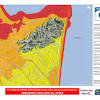Interactive map reveals the ski resorts that could be snow-free by the end of the century thanks to climate ch

- Scientists predict that one in eight skiing areas could be snowless by 2100
- If climate change does not slow, ski resorts might become financially unviable
By Wiliam Hunter
Published: 18:00 GMT, 13 March 2024 | Updated: 18:00 GMT, 13 March 2024
Every year, an estimated 400 million people visit ski resorts, looking for some action on the slopes.
But trips to many of the world's most popular resorts could soon become a thing of the past due to a lack of snow caused by climate change.
Researchers from the University of Bayreuth, Germany found that one in eight ski sites will have no days of snow cover at all by the end of the century.
From the Australian Alps to the Andes, this shocking map reveals the areas likely to be snow-free or shut down in the next 75 years.
So, is your favourite resort at risk of vanishing for good?
The skiing areas that will have the least days of snow by 2100
- Australian Alps: 38 days of snow
- Japanese Alps: 86 days of snow
- Appalachian Mountains: 116 days of snow
- Southern Alps: 128 days of snow
- European Alps: 137 days of snow
- The Andes: 153 days of snow
- The Rocky Mountains: 202 days of snow
While skiing is both a very popular sport and a highly profitable industry, until now there has been little research into how it might be affected by climate change.
To understand what effect a warming climate might have on skiers, the researchers looked at seven popular skiing areas around the world - the European Alps, Andes Mountains, Appalachian Mountains, Australian Alps, Japanese Alps, Southern Alps (located in New Zealand), and Rocky Mountains.
The team then identified what parts of these regions are used for skiing and used climate models to see how many days of snow coverage they would receive under different emissions scenarios.
The worse scenario is the 'very high emissions' case in which there are no concerted efforts to reduce greenhouse gas emissions.
In this case, both temperatures and emissions would continue to rise, with CO2 emissions doubling by 2100.
Under this scenario, the researchers discovered that 13 per cent of the world's ski areas would be completely snow free by 2071-2100.


This map shows how each ski area identified by the researchers will be affected by climate change by 2100. The purple squares show areas which will receive no days of snow cover, while the yellow dots show regions which will not be affected


Researchers predict that in a high-emission scenario, resorts in the Japanese Alps like this one in Niigata could get 50 per cent fewer days of snow coverage each year
A further 20 per cent would lose more than 50 per cent of their snow days by the same time.
If you happen to ski in Japan, the USA, or Australia, your favourite spots might be in trouble.
Under this scenario, 18 per cent of areas in the Andes, 14 per cent of areas in the Appalachian Mountains, and 17 per cent in the Japanese Alps will no longer have any days of snow cover by 2100.
However, the worst affected areas will be ski resorts in the Southern Hemisphere, with the Australian Alps predicted to see 78 per cent fewer days of snow cover each year, and the Southern Alps and Japanese Alps expected to lose 51 and 50 per cent of their snow days respectively.


Resorts in the European Alps like this could have 42 per cent fewer days of snow coverage each year by the end of the century
Even the European Alps, where 69 per cent of the world's ski areas are located, are expected to have 42 per cent fewer days of snow cover by 2100.
The findings come as Alpine areas see rapid warming due to climate change.
Some studies have predicted that almost all alpine glaciers could completely vanish by the end of the century.
Worryingly, some areas are even expected to fall below the '100 day rule', which suggests that a resort with less than 100 days of snow cover is not economically viable.
Both the Australian Alps and Japanese Alps may cease to be viable skiing locations by 2100 with only 38 and 86 days of snow each year under a high emissions scenario.
Lead researcher Veronika Mitterwallner told MailOnline: 'We already observe temporal and spatial changes of reliable snow cover in ski areas, resulting in a concentration on fewer ski areas.
'This has the effect of making skiing less easily accessible than it has been, and this trend will be further amplified by climate change in the future.'


Ski resorts in the Australian Alps (pictured) could cease to be economically viable as the days of snow cover could fall below 100 days
The study also reveals that ski areas closer to more populated areas will be more affected by climate change.
Highly populated areas will lose 55 per cent of snow cover days in a very high emissions scenario and 49 per cent in a high emissions scenario.
Ms Mitterwallner says: 'Our study indicates that ski areas located on the outer and lower sections of mountain ranges, as well as more coastal resorts, will be particularly susceptible to the impacts of climate change.'
More remote areas meanwhile, such as the more mountainous regions to the south of the European Alps will be less affected.
The researchers suggest that this could lead to ski resorts moving into more and more remote areas.
They suggest that this could lead to the degradation of already fragile mountainous ecosystems and the loss of local plants and animals.
The researchers, in their paper published in PLoS ONE, write: 'This study demonstrates significant future losses in natural snow cover of current ski areas worldwide, indicating spatial shifts of ski area distributions, potentially threatening high-elevation ecosystems.'


 New Zealand
New Zealand Argentina
Argentina  Australia
Australia  Austria
Austria  Brazil
Brazil  Canada
Canada  Germany
Germany  Ireland
Ireland  Italy
Italy  Malaysia
Malaysia  Mexico
Mexico  Poland
Poland  South Africa
South Africa  United Kingdom
United Kingdom  United States
United States 























